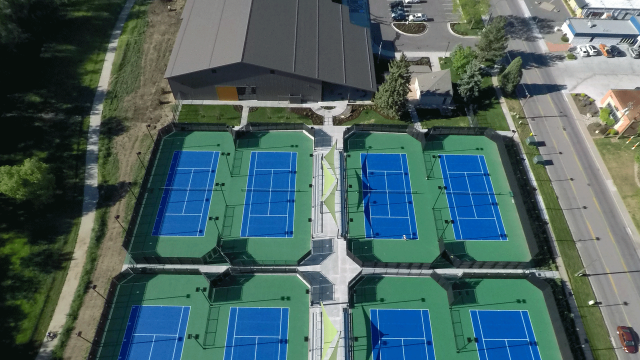FAQ Tennis Courts
Building a tennis court isn’t a simple project. It comes with a multitude of decisions and precise calculations. Not sure how to get started? Have questions? Our frequently asked questions section will help you get started.
Our Renner experts are always here to help. Contact us now, Get Started.
What is the recommended area for a tennis court?
The size of a single court is recommended at 60′ x 120′. The minimum required dimensions per the International Tennis Federation is 56′ x 114′. Stadium courts should be 66′ x 132′ to allow for judges. Multiple court complexes are recommended for each court to be 60′ x 120′, which allows 24′ between the courts. The preferred minimum between courts is 18′ and the absolute minimum space between courts 12′. This diagram shows the layout and measurements of a tennis court per USTA regulations.
What is the slope of a tennis court?
Hard courts should slope in one plane; side-to-side, end-to-end, or corner-to-corner, at a minimum of 1″ in 10′ (0.833%) and a maximum of 1%. Clay courts should slope in one plane at 1″ in 30′ to 1″ in 40′.
What kinds of substrates are required?
Substrates for hard tennis courts are either asphalt or concrete. Asphalt has a lower initial cost of installation, but will begin to deteriorate quickly. At five years structural cracks have developed or are developing, as well as birdbaths (depressions in the asphalt). At 20 years major restoration work is required. Concrete can either be reinforced or post-tensioned. Reinforced concrete courts are recommended to be 5″ thick with #4 rebar placed 12″ on center, both directions. Each ½ court should be cast at one time, with no intervening joints. With no jointing, expect random cracking to occur, but due to the rebar, they will open only minimally. Post-tensioned concrete utilizes steel cables in a plastic sheathing, which are placed in a grid through out the slab. A minimum of one full-court is placed at one time, and the cables are stressed to 33,000 psi once the concrete has reached a minimum strength of 2,700 psi (typically 5 to 7 days). Although random cracking is likely to occur, the cable compression will keep them to a hairline crack and not allow displacement. This is the most structurally sound method of construction. Substrates for clay courts should be properly compacted road base or non-expansive native soils. For Sand-Filled Turf courts, asphalt or concrete is recommended, although they can be constructed on properly prepared road base materials.
What kinds of surfaces are available?
Acrylic color coatings are standard hard court surfaces. These are comprised of resurfacer coats for blending/smoothing and color coats for texture and aesthetics. Cushioned surfaces are installed on hard-court substrates, such as concrete or asphalt. The cushioned surface can either be an acrylic-and-rubber build up system or a textile product. There are several options for each type of cushioned surface, all with varying degrees of cushion. Sand-filled Turf surfaces can be installed on either concrete, asphalt or a properly prepared gravel base. These surfaces are finding a niche in the industry as a rehabilitative surface, being placed over severely cracked substrates. There are several manufacturers of these surfaces, each with certain attributes. Har-Tru Clay surfaces are comprised of aggregate bases, with crushed granite as the actual play surface. Most installations are new facilities, although it is becoming more common to rebuild existing facilities by overlaying the existing courts with a clay court system.
What resurfacing options are available for hard courts?
Standard resurfacing includes crack filling and re-coating of the acrylic surface. Birdbath leveling may or may not be included, depending on their severity and the customers’ budget. Structural cracks, although filled, will reopen, although in diminished form, due to thermal expansion/contraction. The sand-filled turf systems and some of the textile cushion systems can be installed over cracked substrates to prevent the cracks from interfering with play. These surfaces are free-floating over the surface area of the court to allow the cracks to continue movement without reflecting through.
What size fences are required for tennis courts?
Recommended fence height for tennis courts is 10′ or 12′, with 10′ high being the most common height. As the majority of tennis balls will bounce to the ends or the corners, the high fence is required at each end, returning along the sides for a minimum of 20′. At this point, the side fences can be reduced in height, or even eliminated, to allow for viewing onto the court.
What types of fencing are recommended?
Standard fencing for tennis courts is a chain link fencing system. Options for chain link fencing include Galvanized chain link systems and Vinyl-coated chain link fence systems. Options for fencing can include wooden posts and rails with chain link fence fabric, wooden picket fences, or a soft-fence, which is a nylon mesh netting.
Should an architect and/or engineer be involved with my project?
In instances where a total site development or reconstruction is to be done, a landscape architect can offer a total “vision” of the completed project. This can include plantings, irrigation, walls, etc. In instances where a tennis court is to be constructed on an existing landscaped lot, or if the owner has a plan for amenities and plantings, an architect would not be required. Although not required, a soils report prepared by a soils engineer can offer invaluable insight to sub-surface conditions, and recommend procedures to overcome any problems that may lie beneath. We do not generally include this cost in our proposals, but we do recommend that the owner consider such. Problems that may be encountered might be expansive soils, underground springs, or substantial organic materials that may deteriorate. Typically, a property owner has already had this evaluation done when constructing structures on it. We can prepare engineered drawings for permitting and construction, for the tennis court, drains, retaining walls, lighting, etc.

